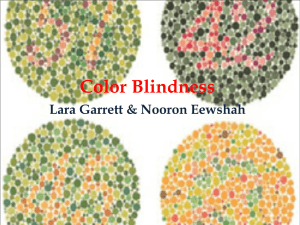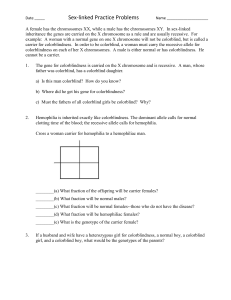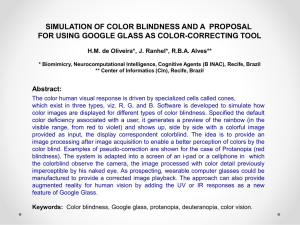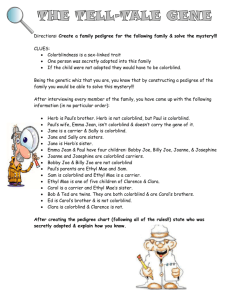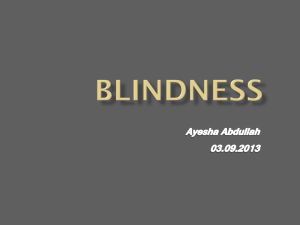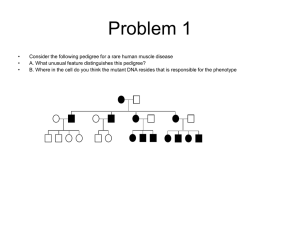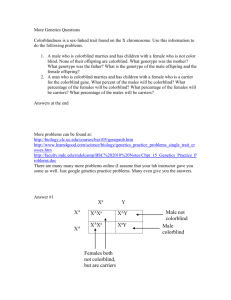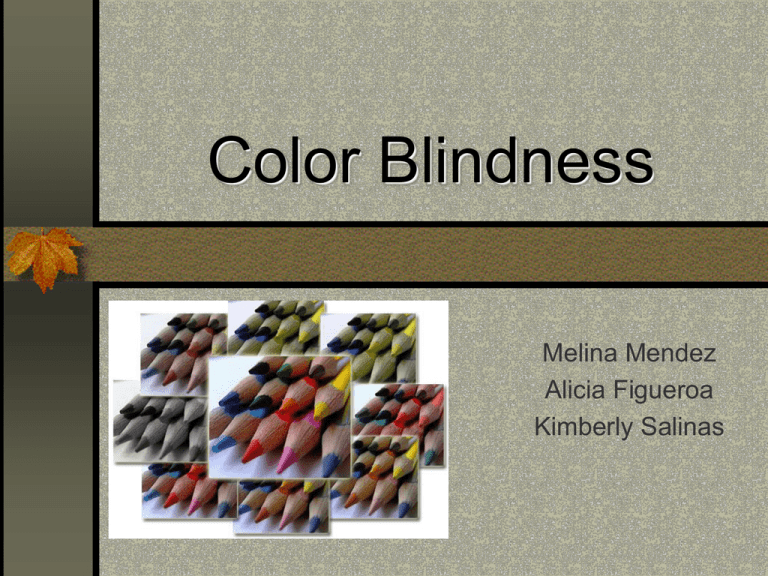
Color Blindness
Melina Mendez
Alicia Figueroa
Kimberly Salinas
Group Questions:
What do you know about genetic disorders in general?
We know that genetic disorders are inherited from the parents of the affected
person. I also know the parent could be a carrier, This means that the phenotype
doesn’t have to be like that of the affected child. Some genetic disorders are sex
linked.
In which Context have you heard about Genetic Disorders?
They are heard all over. There are many that are common like down syndrome and
color blindness.
Why do you choose this particular disease?
We chose this disorder because we know some of the consequences of this disease
and we wanted to see why this disorder affects a person so much.
What do you want to find out about this disorder?
We want to know how a person’s life will be different because of this disease and
where it originated from.
Do you know anyone with this disorder?
Yes we do actually. Melina’s brother has red green color blindness and Kimberly’s
childhood friend cannot see any color.
What is Color Blindness?
Color Blindness is a defect in vision that
makes it difficult/impossible for a person
to distinguish between or among colors.
Genetic Counselor:
How did this child get color blindness?
Colorblindness is caused by the X-linked
gene. Males are usually affected because
they only need one X, where females
need both. This child must have had a
parent carrier.
What is the survival rate?
Everyone survives having Color Blindness but
it can worsen.
Is it treatable? If so, what are the
treatments?
There is no treatment for Color Blindness.
Disorder Specialist:
Is color blindness recessive
or dominant?
Color blindness is x-linked
recessive.
Is color blindness a gene or
Chromosomal disorder?
It is a chromosomal.
What are the symptoms?
The symptoms vary. some
people may be able to see
every color but not
distinguish red or green.
Other may not be able to see
blue or yellow. Lastly, some
people may not be able to
see color at all. They may
just be able to see shades of
black, white and gray. This
however is very rare.
How could this have been predicted before the
child was born?
There could have
been the possibility
of checking both
parents’ X
chromosomes
(male=1
Females=2).
Parent:
What kind of lifestyle will your child have with
being colorblind?
My child will not be able to differentiate certain
colors for this defect is not curable. My child can either
have proton, deuton, or triton defects. She/He might
only be able to tell about 20 hues apart from each
other, rather than an average person which can tell
about 100 hues apart from each other. My child could
have colored lenses or glasses that can help with their
colorblindness but cannot give him/her their vision
back. My child will feel handicapped in everyday life
but almost no one will recognize it. My child may be
rejected from a job assignment due to his/her
colorblindness. My child will not receive any treatment
for there is none. Their careers cannot be a police
officer, firefighter, or a pilot. My child will have
problems matching clothes or buying ripe bananas. In
certain countries my child won’t be able to get his/her
driver’s license. If she/he drives they will be at risk of
traffic light accidents.
How long your child will live?
Colorblindness does not have any affect on my
child’s life expectancy.
If your child with the disorder will be able to
have children of his/her own and if his/her
children will be affected?
If my child was a boy
he cannot pass his redgreen colorblindness to
his sons. If my child
was a girl and has redgreen colorblindness
then all her sons will be
colorblind since the
women have the
dominant colorblind trait
(X chromosome).
If you were to have more children, what is the
probability that another child will be affected by the
same disorder?
If my husband isn’t
colorblind and I am a
carrier it will be a 25%
chance for a girl to be a
carrier and a boy to be
colorblind. If my
husband is colorblind
and I am a carrier then
it would be a 25%
chance for a girl to be
either a carrier or
colorblind and a 25%
chance for a boy to be
colorblind.

